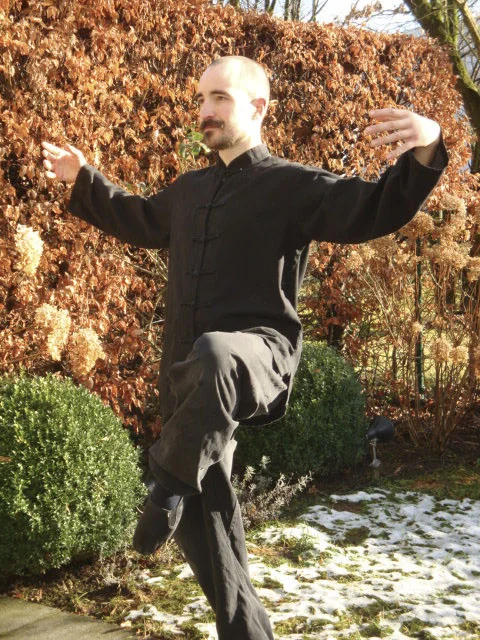*Spotlights on Tai Chi*
Die Wurzeln des Tai Chi reichen zurück bis zur Morgendämmerung des Menschengeschlechts... leider nein, auch wenn ich das schon immer mal schreiben wollte.
Auch wenn wir bei Tai Chi ebenso wie bei Kung Fu eine legendäre Gründerfigur haben (den taoistischen Mönch Zhang Sanfeng) wie im Kung Fu mit Bodhidharma, die ebenfalls den Kampf eines weißen Kranichs mit einer Schlange beobachtet haben soll, worauf ihr dann die zentrale Einsicht kam, das zu konstruierende System an Bewegungen von Tieren zu orientieren, ist der Ursprung des Tai Chi historisch im Dunklen, Datierungsveruche reichen vom 10. Jh. bis zum 15. Jh., wobei man sich jedoch offenbar recht einig in der Frage ist, daß das Ursprungsland dieser internen Kampfkunst China gewesen ist.
Der Begriff Kampfkunst im Zusammenhang mit Tai Chi mag viele Leser, die es als auf Gesundheit und Entspannung zielende Meditation in Bewegung kennengelernt haben, überraschen, daher hier ein paar Worte zum Unterschied von internen zu externen Kampfkünsten bzw. harten und weichen Stilen.
Während in harten Stilen v. a. Muskelkraft zum Einsatz kommt und das Qi (die Energie des Körpers) in erster Linie lokal von den Muskeln gehalten wird, um so maximale Effektivität zu erzielen, sind in den sog. weich-harten Stilen die Muskeln bis unmittelbar vor dem Kontakt mit dem Gegner entspannt, was einen besseren Qifluß vom Hara zu den Gliedmaßen ermöglicht, d. h. es steht bei Kontakt mit dem Gegner im Idealfall mehr Qi zur Verfügung, mit dem dieser geschädigt werden kann. In den weichen Stilen bleibt der Körper während der gesamten Konfrontation entspannt, wobei jedoch zum Schutz der Bänder in Schultern und Ellenbogen die Glieder, bevor sie ihre maximale Ausdehnung erreichen, zurückgezogen werden; dabei werden die Muskeln und Sehnen instantan angespannt, wodurch die Bänder geschützt werden, um dann sofort in den entspannten Zustand zurückzukehren. Die Bewegung funktioniert sozusagen wie ein Peitschenschlag. (Nach: Yang Jwing-Ming, “The Essence of Shaolin White Crane”, p. 17 & 18).
Kurz: Es läßt sich auch mit weichen, (auch oftmals auf das Umleiten der vom Gegner eingesetzten Energie zielenden) Bewegungen äußerst effektiv kämpfen, nur daß diese anwendungsorientierte Form des Tai Chi im Westen ungleich weniger Bekanntheit erlangt hat als das rein zu Meditations- und Entspannungszwecken verwendete, formengebundene Tai Chi, bei dem es sich traditionellerweise um längere Sequenzen oftmals recht komplexer Bewegungsabläufe handelt, bei denen die Bewegungen von Tieren imitiert werden. Die traditionellen Tiere im thailändischen Süa Lag Hang Stil, der an der Kampfkunstschule Ajahn Lao in München unterrichtet wird, sind Affe, Kranich, Tiger, Schlange, Bär und Tanzvogel; dieses Programm wird noch erweitert um die traditionellen Waffen Stock, Schwert und Doppelschwert. Richtig praktiziert dauert eine solche Form mindestens 10 Minuten, ein geübter, in sich ruhender Übender mag aber auch doppelt so lang, wenn nicht dreimal so lang für eine Form benötigen.
Betreibt man Tai Chi nun nicht als tatsächliche Kampfkunst, sondern als Meditationsform, hat man sich folgendes zu vergegenwärtigen: Während man in Disziplinen wie Yoga oder Qi Gong aufgrund der relativen Einfachkeit vieler Übungen, die eine gute Synchronisation mit der Atmung erlauben, bereits früh gewisse “Erfolge” in Form von Entspannung, Wahrnehmung von Energieaufbau oder Energiefluß im Körper etc. verzeichnen, so wird sich dies kaum eins zu eins auf die Praxis des Tai Chi übertragen lassen: Die Bewegungsabläufe sind vergleichsweise komplex und allein die Synchronisation von Arm- und Beinarbeit wird den ungeübten Anfänger vor gewisse Herausforderungen stellen, während eine vollständige Synchronisierung sämtlicher Bewegungen mit dem Fluß der Atmung beim Großteil der Schüler sogar noch länger auf sich warten läßt. Geduld ist also gefragt. Doch wer die mögliche “Dürreperiode” am Anfang übersteht, den erwartet eine reiche Ernte: Körper, Bewegungen und Geist werden schließlich wie eine Stein, der in langen Jahren vom Wasser abgeschliffen wird, weich, elastisch und finden in Harmonie, mit den Jahren mag man sogar feststellen, daß sich bereits in kürzester Zeit nach dem Beginn einer Form der sog. “Qifluß” einstellt, der in der Form eines leichten Prickelns auf und unter der Haut spürbar wird. Allein wer dieses Gefühl einmal erlebt hat, wird verstehen, warum viele Übende danach regelrecht süchtig werden (das Gute daran ist: es hat keinerlei negative Nebeneffekte, nur eine größere Harmonie von Körper und Geist und ein vertiefte Entspannung werden sich über die die Jahre einstellen). Wer dies nun noch durch gesunde Ernährung und regelmäßiges Meditieren ergänzt, ist, je nach buddhistischer oder taoistischer Vorliebe, auf dem besten Weg zur Erleuchtung bzw. zur Unsterblichkeit.
Text von G.M. Knauer
*The roots of Tai Chi reach back to the dawn of mankind... unfortunately not, although I've always wanted to write this.
Even if we have a legendary founding figure for Tai Chi (the Taoist monk Zhang Sanfeng) who just like Bodhidharma in Kung Fu supposedly watched the fight of a white crane against a snake which gave him the central insight to orient the system-in-the-making on the movements of animals, the origin of Tai Chi is lost in the murk of history, attempts to date it reach from the 10th. century to the 15th. whereby obviously historians are of one mind concerning the country of origin of this internal martial art, namely China.
The term martial art in connection with Tai Chi may surprise many readers who are acquainted with it as a form of moving meditation aiming for relaxation and health, so here a few words on the difference of internal and external martial arts or hard and soft styles, respectively:
While in hard styles it is mostly muscular strength that is applied while the Qi (the energy of the body) is being held locally by the muscles to reach maximum effectiveness, in the so-called soft-hard styles the muscles are relaxed up to the very point before contact with the opponent is established which allows for a better Qi-circulation from the Hara (centre of the body) to the limbs, i. e. this will ideally provide the limbs with more Qi with which to damage the opponent. In soft styles the body remains relaxed throughout the whole confrontation whereby for the protection of the ligaments in the shoulders and ellbows the limbs are pulled back before they reach their maximum extension; at this point the muscles and tendons are instantly tensed (which protects the ligaments) to return into their former relaxed state immediately. (Based on: Yang Jwing-Ming, “The Essence of Shaolin White Crane”, p. 17 & 18).
To put it briefly: It is quite possible to fight effectively with soft movements mainly aiming for the redirecting of the energy applied by the opponent, but this application-oriented form of Tai Chi has gained considerably less prominence in the west than its form-bound version used solely for the sake of meditation and relaxation which traditionally consists of extended sequences of movements imitating animals. The traditional animals of the Thai Süa Lag Hang style which is taught at the Ajahn Lao martial arts school in Munich are monkey, crane, tiger, snake, bear and dancing bird; this program is further supplemented by the traditional weapons staff, sword and double-sword. When practised properly, a form will take at least ten minutes but a well-trained practitioner with a calm mind may take twice, even thrice as long for one form.
If one practises Tai Chi not as an actual martial art but as a form of meditation, he has to realise one thing: While one may relatively early achieve “successes” in disciplines like Qi Gong or Yoga (thanks to the relative simplicity of many exercises which allow for an easy synchronisation of movement and breathing) in the form of relaxation, perceiving a building up or even flow of energy, it will hardly ever be the case that this can be transferred to Tai Chi par-for-par: The motion sequences are relatively complex and alone the synchronisation of arms and legs will pose a certain challenge for the untrained beginner while a complete synchronisation of all movements along with the flow of breathing is a long time in the coming with most students. Therefore, patience is required. But he who gets past this possible period of drought at the outset will be able to reap a rich harvest: Like a stone which is polished by the water over many years, his body, movements and mind will become elastic, soft and harmonious with each other, over the years one may even start and perceive that more or less immediately after beginning with a form the Qi-flow starts to set in which can be felt in a tingling sensation on and beneath the skin. A person who has at least once experienced this feeling will understand why many practitioners are getting downright addicted to it (the good part being that this addiction has no negative side-effects whatsoever, only a greater harmony of body and mind and a deepened sense of relaxedness will ensue over the years). If this is further supplemented by a healthy diet and regular meditation, one is – depending if he has Buddhist or Taoist preferences – already enroute to enlightenment or immortality.*
text by G.M. Knauer


